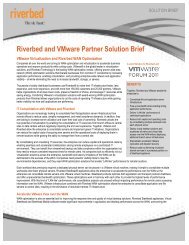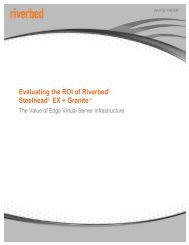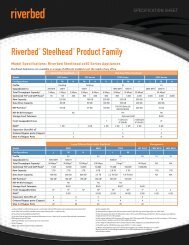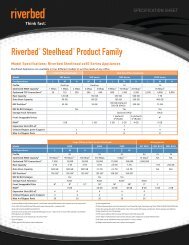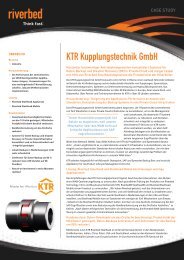Riverbed Optimization System (RiOS) 6.1
Riverbed Optimization System (RiOS) 6.1
Riverbed Optimization System (RiOS) 6.1
You also want an ePaper? Increase the reach of your titles
YUMPU automatically turns print PDFs into web optimized ePapers that Google loves.
<strong>RiOS</strong> Technical Overview<br />
Figure-18: <strong>RiOS</strong> also allows for out-of-path deployment with optional clustering of devices.<br />
For deployments requiring the highest levels of redundancy and performance, <strong>RiOS</strong> also supports warm standby between<br />
designated primary and backup devices. Using automated data store synchronization, the data segments and the references<br />
created via Data Streamlining are automatically copied from the primary to the backup appliance. In the event of a failure in the<br />
primary appliance, the backup appliance will take its place with a hot data store, and can begin delivering fully-optimized<br />
performance immediately. <strong>RiOS</strong> even supports active/active configurations, in which each appliance is serving both as a primary<br />
for some traffic and as a backup for the other appliance, with full data store synchronization. No other vendor can match these<br />
capabilities.<br />
<strong>RiOS</strong> also permits a variety of other in-path, virtual in-path, or out-of-path configurations both parallel and clustered. <strong>RiOS</strong> has<br />
capabilities for integration into even the largest-scale, most-complex networks. Unlike other vendors’ systems, <strong>RiOS</strong> achieves<br />
those capabilities without using dangerous, short-sighted approaches like route injection, fake addressing on the WAN, or unscalable<br />
approaches like explicitly-configured tunnels.<br />
End-to-End Data Security<br />
Historically, customers looking at WAN optimization solutions were often faced with a compromise between security and<br />
performance. They either needed to accept subpar performance while maintaining stringent security measures, or lower the<br />
security bar in order to improve application performance with WAN optimization. With <strong>RiOS</strong>, <strong>Riverbed</strong> eliminates this trade-off by<br />
offering security capabilities to protect data both in motion and at-rest.<br />
<strong>RiOS</strong>’s patent-pending SSL acceleration module allows customers to securely accelerate SSL encrypted traffic without scattering<br />
digital certifications and private keys around the enterprise with seamless integration. Recent SSL sessions can be automatically<br />
re-used, further increasing the performance of SSL traffic while keeping it secure. In addition, <strong>RiOS</strong>’s SSL capability works<br />
alongside existing SSL offload or load-balancing devices. Server IP autodiscovery simplifies the set up of this features, as does<br />
support for wildcard to quick add a range of servers (for example *.riverbed.com). <strong>RiOS</strong> also provides an optional SSL capability<br />
to encrypt the inner-channel communications between Steelhead appliances to secure other data traversing the WAN that is not<br />
otherwise protected.<br />
To protect data at-rest, <strong>RiOS</strong> supports AES encryption of the data store inside Steelhead appliances to meet security or<br />
compliance regulations. AES-128 has been selected as the U.S. government encryption standard and <strong>RiOS</strong> can encrypt data<br />
stores using AES-128, AES-192, and AES-256 bit encryption schemes. It is worth noting that the Steelhead data store contains<br />
short, unique segments rather than entire files or application objects. This makes it hard for an attacker to recover files from the<br />
“shredded” segments in the data store, even without encryption. The optional encryption of the data store provides an additional<br />
level of protection for the most security-conscious organizations.<br />
Steelhead appliances and Virtual Steelhead have a unified trust model offering strong authentication to determine which should<br />
be allowed peer connectivity. This can be based on both self-signed certificates and well known Certificate Authorities.<br />
© 2010 <strong>Riverbed</strong> Technology. All rights reserved. 23




